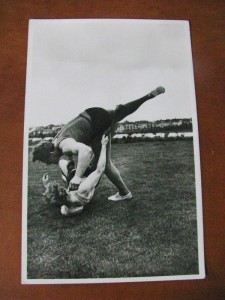Glíma, the ancient wrestling style. Posted by hulda on May 30, 2012 in Icelandic culture, Icelandic customs, Icelandic history, Uncategorized
 When it comes to sports in Iceland there probably isn’t any as traditional as glíma, or glima as it’s written outside of Iceland (the only difference is the accent – i / í – that signals correct pronunciation in Icelandic). As a word (að) glíma means (to) wrestle or (to) fight, in some cases also (to) tackle, giving a clue to one of the most important rules of glíma.
When it comes to sports in Iceland there probably isn’t any as traditional as glíma, or glima as it’s written outside of Iceland (the only difference is the accent – i / í – that signals correct pronunciation in Icelandic). As a word (að) glíma means (to) wrestle or (to) fight, in some cases also (to) tackle, giving a clue to one of the most important rules of glíma.
Glíma is first mentioned in Jónsbók, a book of law that was first written in 1281 with a passage “Nú gengr maðr til leiks, fangs eða skinndráttar at vilja sínum, þá ábyrgist hann sik sjálfr at öllu, þó at hann fái mein eða skaða af…” which loosely translates to “Whosoever participates in a contest of friendly wrestling or hide-tugging does so on his own responsibility…” In other words, at its origin glíma always carried a great risk of injury, even though it was divided in two types, “leikfang” which was supposedly just a manly kind of playing around and the duel-style where the aim was to kill the opponent by slamming him to a tapered, waist-tall stone in the middle of the wrestling ground, breaking either his ribs of back in process. Apparently even leikfang was dangerous enough to warrant a mention in a book of law so I think it’s safe to assume injuries of all kinds were more the norm than not.
Today glíma has thankfully turned into a far more peaceful sport. It exists in roughly three forms: glíma, hryggspenna (back-spanning) and lausatök (loose grip). Of these glíma is the one that’s considered the most basic way, hryggspenna is more a test of strength than wrestling and lausatök which is perhaps the most like the old type of wrestling is more lenient on the rules of what is and isn’t acceptable and far more aggressive than the basic form. Lausatök is also considered a form of self-defense and is taught as a martial art in several Scandinavian countries.
The most notable part of glíma are the wrestling belts used to get a grip of the opponent. These have one belt going around the waist and two around the thighs that are connected to the waist belt by straps, but other than that the outfits vary greatly depending on which type of glíma is considered and what the situation is. Some even wrestle in full medieval era style clothes!
 The main rule is that the opponent must be thrown down. That means that if the opponent isn’t going down with a throw it’s not acceptable to push him or fall on top of him (this part of the rules is called nið). Both wrestlers have to be standing up straight (upprétt staða) and the usual way of wrestling in setsquare form as it exists elsewhere is banned. The wrestlers have to step back and forth clock-wise (stígandinn) at all times. It’s also good form to look over your opponent’s shoulder and not at them because the real art of glíma is to respond to your opponent’s movements without seeing them.
The main rule is that the opponent must be thrown down. That means that if the opponent isn’t going down with a throw it’s not acceptable to push him or fall on top of him (this part of the rules is called nið). Both wrestlers have to be standing up straight (upprétt staða) and the usual way of wrestling in setsquare form as it exists elsewhere is banned. The wrestlers have to step back and forth clock-wise (stígandinn) at all times. It’s also good form to look over your opponent’s shoulder and not at them because the real art of glíma is to respond to your opponent’s movements without seeing them.
Aside from these, in lausatök the rules state that the one left standing when the other one is down is the winner of the match, which means that in case of both contestants falling down they then try to keep the other on the ground while attempting to stand up. The usual glíma code of honour, drengskapur (lit. transl. “noble-mindedness”), is however still adhered to, stressing the importance of respect towards your opponent, fairness in fight and avoiding to cause real injuries.
Glíma has two national awards, Grettisbelti (Grettir’s belt) for men and Freyjumen (Freyja’s jewel) for Freyjuglíma, women’s glíma that takes its name from the same goddess. Grettir, after whom the men’s trophy is named, was a legendary saga hero who wrestled with and killed an undead giant, yet another Icelandic type of ghost. For his heroics the giant cursed him and that curse would eventually lead to his death but before that, Grettir managed all kinds of heroic tasks, among them the fact that he stayed alive for almost 20 years as an outlaw, setting a record that was never broken. Freyjumen very likely refers to Freyja’s most known piece of jewellery, the Brisingamen (jewel of the Brisingars).
I suppose this one could be called artist’s vision of the sport?
You can see real glíma matches from two very different times here and here!

Build vocabulary, practice pronunciation, and more with Transparent Language Online. Available anytime, anywhere, on any device.
About the Author: hulda
Hi, I'm Hulda, originally Finnish but now living in the suburbs of Reykjavík. I'm here to help you in any way I can if you're considering learning Icelandic. Nice to meet you!




